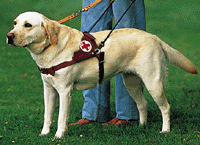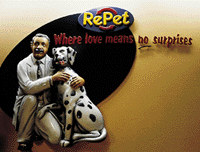


But we anticipate success soon. At Advanced Cell Technology (ACT), we have undertaken a research program that uses cloning technology to propagate pets as well as service animals such as seeing-eye dogs for the blind, hearing dogs for the deaf, search-and-rescue dogs, and animals used for social therapy. Together with Louisiana State University, the Audubon Institute has teamed up with a company called Lazaron BioTechnologies in Baton Rouge, La., to clone pet dogs and cats.
 |
 |
A surprising number of people are interested in cloning their favorite deceased pet in the hope of getting an animal with similar behavioral characteristics. A good deal of a cat or dog's demeanor is thought to be genetically determined. Although one can argue that there are already plenty of cats and dogs in the world that need homes, people still use traditional breeding methods to try to reproduce a particularly desirable animal. Cloning could offer a more efficient alternative. It could be particularly important in the case of service animals. Currently, for instance, male seeing-eye dogs are neutered at an early age so that they can concentrate better during their expensive and rigorous training. So, unfortunately, even if a dog turns out to be very good at his job, he can't be bred to produce more like him.
Our efforts to clone pets could also pay off for endangered species. We expect to be able to apply the information we obtain from cloning cats and dogs to preserving endangered felines and canines.
ACT and several other companies now offer pet cloning kits that veterinarians can use to preserve samples from a client's pet for possible future cloning. The kits contain materials for collecting a skin specimen and sending it back to a laboratory. Research assistants there use the tissue to establish a collection of pure, dividing cells called a cell line, which will be the source of donor cells for cloning. ACT extracts eggs for the cloning procedure from reproductive tracts taken from animals that have been spayed by veterinarians. We remove the ovaries and carefully puncture all visible follicles to release the eggs. Then we collect the eggs and place them in a specialized maturation medium that contains hormones, proteins and nutrients. Once fully matured, the eggs are ready for the nuclear transfer procedure [see illustration on pages 68 and 69].
So far our main focus has been the domestic cat, primarily because its reproductive physiology has been well studied, and embryo transfers of early- and late-stage embryos have resulted in the birth of live kittens. Both ACT and the Audubon Institute have been able to establish systems for prompting cat eggs to mature in the lab and have consistently produced cloned embryos that are being transferred to recipients.
But dogs are a different story. The dog's reproductive physiology is unique among mammalian species. Dogs ovulate an immature egg that has a very long maturation time. This means that we need a different maturation system from the one we have used in cats and that we have fewer eggs to work with in the end. So Fluffy will probably have a leg up on Rover when it comes to cloning. --R.P.L., B.L.D. and P.D.
Back to Article (Cloning Noah's Ark)